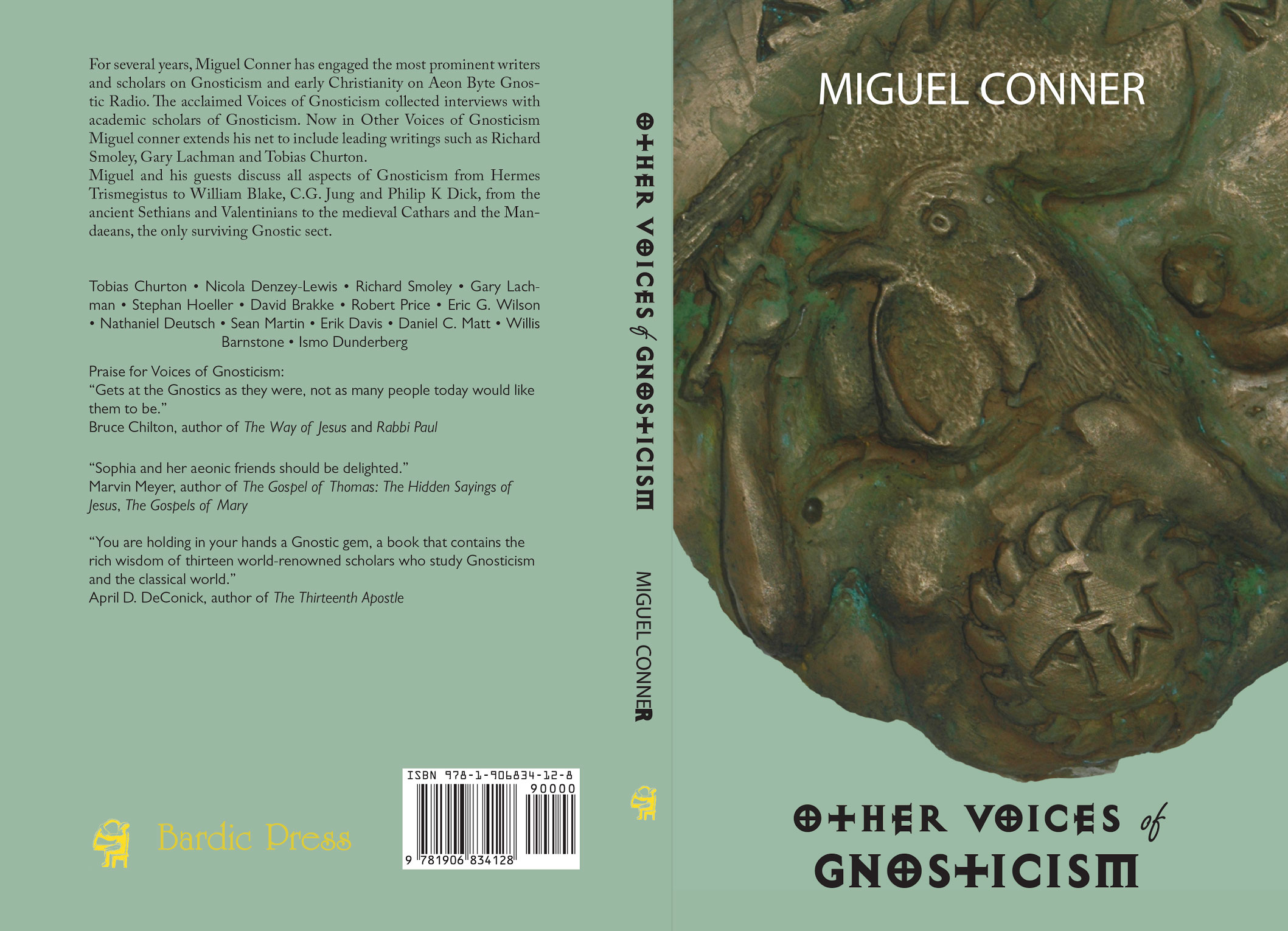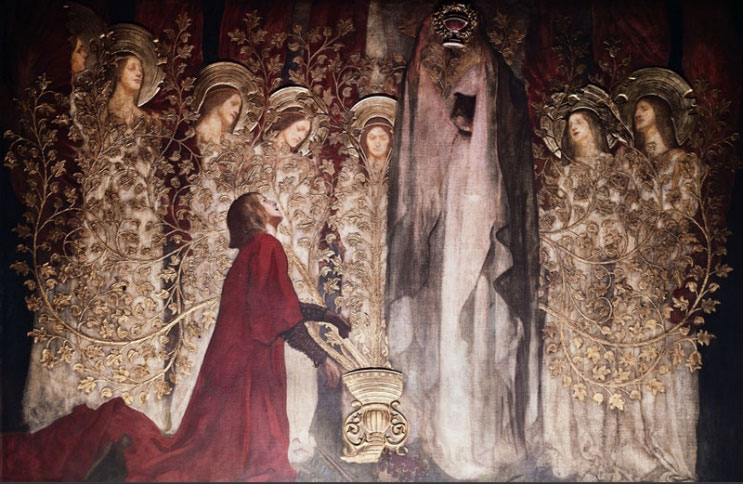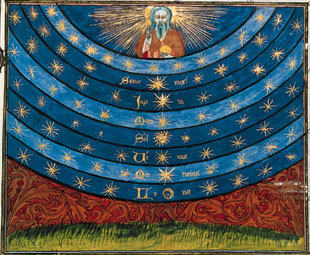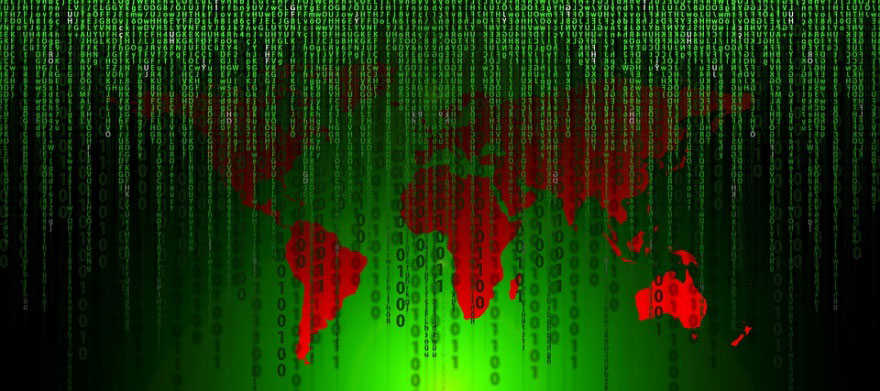It is with great pleasure that we welcome our Author of the Month for April, Miguel Conner, with the second book in his series, Voices of Gnosticism.
“You are holding in your hands a Gnostic gem, a book that contains the rich wisdom of thirteen world-renowned scholars who study Gnosticism and the classical world.”
– April D. DeConick on Other Voices of Gnosticism.
A candidate wins the U.S. presidency and a considerable part of the population rejects the results, embracing exotic stories of birth certificates or Russian meddling. Captains of commerce like Elon Musk contemplate that humanity might be living in a simulated reality. Claims of a flat Earth or lizard overlords are widely shared on Facebook walls alongside vacation and children pics. A sense of alienation settles upon a world population that no longer trusts its religious, political, or educational institutions. Being paranoid is no longer a personality defect but a survival skill, for many, and every movement seems to grudgingly accept its conspiracy theory wing like that bombastic uncle at Christmas dinner.
We are living in Gnostic times.
That’s the case I’ll be making. Sure, to many the ancient Gnostics are a historical curiosity, mystic heretics of early Christian times that lost to those victors who wrote our history. To others, Gnosticism is the fuel injection that fires the imagination of occult organizations and secret societies still believing they are secret; or the works of William Blake, Philip K. Dick, and Philip Pullman, as well as the screenwriting of such modern myths as The Matrix. Some academics like Michael Williams (Rethinking Gnosticism) and Karen King (What is Gnosticism?) claim it never even existed at all.
The Gnostics existed, though, and their essence is in our midst. Does that mean the Gnostic nightmare has finally come true, warned in their byzantine, protean gospels?
In a way it has, though, but in a way these times are missing an ingredient that made the Gnostics so dangerous to world rulers. First, to understand how the Gnostic sensibility has partly returned and what is missing, we’d better get acquainted with Gnosticism.
What is Gnosticism?
The origins of the Gnostics are still debated. Most academics assume Gnosticism emerged during the second or third century A.D., although others presume a much earlier date – perhaps from ancient Jewish, Mesopotamian, or Egyptian origins. As April DeConick argues in The Gnostic New Age, the beginning of Gnosticism is a straw man since it was never really a religion but a metaphysical orientation found in many old cultures and drawing from many traditions that coalesced in nascent Christendom. This fluidity of Gnosticism and the fact so few of their works survived has made it frustrating for both scholars and occultists to understand Gnostic tenets. However, the discovery and study of the Nag Hammadi codices supply a clearer picture of the Gnostics — especially when paired with the latest research from DeConick’s book, Dylan Burns (Apocalypse of the Alien God), and David Brakke (The Gnostics).
Thus, drawing from these scholars and other research, we can deduce four intrinsic hallmarks of Gnosticism:
- We do live in a simulated reality, Elon, a prison planet (at worst) or a distracting illusion (at best). This simulated reality is controlled by stellar wardens or cosmic ranchers that, though divine perhaps, are ultimately deficient overseers of a deficient universe. And, in some cases, they feed upon our souls (or divine sparks, as some Gnostics named it) to fuel the cosmos itself. These stellar wardens — in some narrative no more than ignorant, rebellious angels — were typically called archons (Greek for “rulers”) in Gnostic texts; their leader was sometimes known as the Demiurge (“Greek” for “public worker” and often associated with the Old Testament deity).
- Our true origin, as Philip K. Dick said, is in the stars (or more likely beyond the stars).i We have forgotten our extraterrestrial heritage, most of us suffering from amnesia through many incarnations of bad karma software. Our divine spark belongs to a hitherto unknown and good god outside the material domains. How this separation occurred varies in Gnostic narratives, sometimes a pre-creation cataclysm to simply a supreme consciousness wrestling with its self-awareness.
- To those of us ready, an awakening occurs to our supernal origins, typically brought about by the call or teachings of a transcendent revealer or teacher of righteousness. This is the Red Pill or what was known as Gnosis – experiential knowledge or acquaintance with higher, idealized states of existence. Think of Morpheus courting Neo in The Matrix. For the ancient Gnostics, the transcendent revealer took varied forms that included Jesus, Zoroaster, Mary Magdalene, Seth the third son of Adam, or the Luciferian goddess Sophia. The Manichaeans, a missionary Gnostic sect, placed the Buddha at that lofty level.
- Through ecstatic rituals, the newly awakened beings could take astral flights beyond the world, bypassing the heavenly realms ruled by the archons, and commune with aspects of the good god who resided not in a place but a state of being called the Eternal Realm, the Treasury of Light, or the Pleroma (Greek for “fullness”). The goal for the nascent Gnostic, then, was to become fully angelic, unrestrained by the forces of fate and flesh. The promise is elucidated in the Gnostic Gospel of Philip where it says, “you saw Christ, you became Christ.”
It’s key to mention that with these four hallmarks, the idea of self-knowledge weaves throughout them like a gravitational binding. The journey inward was as crucial as the journey outward, and could lead to the same place. As Elaine Pagels wrote in The Gnostic Gospels, “Yet to know oneself, at the deepest level is to know God; this is the secret of Gnosis.”ii
And it’s helpful to keep the self-knowledge theme in mind when approaching any Gnostic work. As William T. Vollmann wrote in The New York Times:
“As a corpus, the (Gnostic) scriptures are nearly incoherent, like a crowd of sages, mystics and madmen all speaking at once. But always they call upon us to know ourselves.”iii
With that in mind, these hallmarks can help us define various groups as part of the historical Gnostic stream, whether it’s the Sethians, Hermetics, Cathars, Mandaeans, Yezidi, and even forms of Kabbalah and Sufism. The hallmarks do not create an ideal box, though there isn’t one for any religion or philosophy. Nonetheless, they reveal the unique, metaphysical orientation that defines a wide and diverse cultural array of Gnostic groups that exist even today, as with the Mandaeans and Yezidi.
The four hallmarks certainly work with the definition of other scholars — for example with the one of preeminent biblical scholar, Bart Ehrman, in my book, Voices of Gnosticism:
“In the case of Gnosticism, Gnosis is the very basis of salvation. One comes to Gnosis by having it revealed to that person, and through that revelation is awakened from ignorance, from sleep, or from drunkenness, which are various metaphors that are used for the state of the human being before he or she received Gnosis. Once Gnosis is revealed to that person and is accepted by that person, it’s ultimately the basis for integration into the world of the divine from which that person had originated. One of the essential features of Gnosis in terms of its content is that the knowledge that saves is the knowledge that the world in which we live is not the eternal world and our innermost beings are divine and consubstantial with a divine being who is beyond the world, and ultimately is not responsible for its creation.”iv
Gnosticism in a modern context
Beyond the powerful and radical motifs Gnosticism offers for modern visual art, as found in films like The Truman Show, Inception, or (again) The Matrix, or in such television series as The Prisoner or the reboot of Westworld, one of the advantages of Gnosticism is that it can be taken as literal, literally, spiritually, or psychologically as one wants. As an illustration, Carl Jung based much of his depth psychology theories on Gnostic cosmology, mainly because he saw Gnosticism as a discipline that efficiently burrowed into the subconscious for therapeutic insights. In the same stream, scholar Stevan Davies said: “The Savior is not a celestial being brought to earth; the Savior is a capacity of the mind, and the Savior’s journey from above is actually one’s own insight journeying from within.”v
Or Gnosticism can be taken as politically as one wants, whether alien reptilian rulers or Deep State takes the place of the Demiurge and his archons. To the Gnostic, reality was negotiable; escape from the constraints of this world was not. And to those in power throughout history, the Gnostic rabid suspicion of authority, rejection of earthly systems, denial of creator gods, and artistic individuality was unacceptable. They had to go because they had seen the man behind the curtain and made a run for the hot air balloon of individuality. The Gnostics declared all of reality was fake news and alternative facts and a Mandela Effect. As DeConick writes in her book, “The ideas in Gnostic scriptures are not innocent. They are not innocuous. Rather, they are provocative. They involve risk. They call into question. They stir up and incite.”vi She also writes that “the Gnostic scripture didn’t become forbidden scriptures. They were forbidden scriptures.”vii
As can be seen, the Gnostic attitude has soaked today’s culture, in some level or another. The game is rigged, the dice was loaded from the start. The best we can do is troll and protest the cosmos and its bad karma software engineers — go on otherworldly adventures to places where ruling angels fear to tread to find relief and a sense of wholeness.
The missing ingredient to today’s Gnostic attitude
Despite today’s culture embracing both a mutinous and escapist attitude, it still misses the mark of the ancient Gnostics. And despite their existential cred of alienation bordering on nihilism, the Gnostic outlook was refreshingly positive and gripped by a fiery joy. Sure, Gnostic texts like the Secret Book of John or the Gospel of Truth portray a fallen world of Lovecraftian foes. However, there is a rescue operation at all times from higher forces. Everything is going to be alright if we would just wake up and become Christian Bodhisattvas as is our right.
Beyond a lack of hope (or you might call it faith), there is still that one crucial ingredient missing from society today that falls short of a full-blown Gnostic mindset (and that of other ancient esoteric movements). It’s best explained by Philip K. Dick scholar Erik Davies:
“I’d like to suggest instead that the impulse to transcend — the Neoplatonist’s ascent through the spheres, the Gnostics’ sudden awakening, the desert monk’s rejection of the elan vital — is not simply a philosophical error or the mark of patriarchy, but is fired by an intensely lucid yearning of the highest of goals: liberation.”viii
Yes, more than anything the Gnostics sought freedom – untamed, unapologetic freedom. That, in truth, is perhaps why they were considered the greatest of heretics to both secular and religious authorities: they wanted a freedom not stored in any material construct.
A true modern Gnostic would be closer to the Positive Existentialism or Outsider trope provided by British author Colin Wilson. As Gary Lachman wrote in his biography of Wilson, Beyond the Robot:
“The Outsider is someone who sees “too deep and too much” and that most of what he sees is “chaos.” He or she lives in the world with a sense of “strangeness” and “unreality.” The safe, stable reality that most of us perceive is for the Outsider an illusion, a façade obscuring a more dangerous and threatening possibility: that of nothingness, nihilism, and the void, the complete inconsequentiality of human life and all its achievements. For the Outsider, the values and meanings that constitute life for most people — a good job, a big home, a nice bank account — are empty and makeshift; they are, at best, “attempts to gloss over, to make look civilized and rational something that is savage, unorganized, irrational.” He stands for Reality. He seeks a meaning and purpose that the everyday world cannot provide and his salvation lies in understanding this and embracing it with total conviction.”ix
That would be Gnosticism in modern times. That is where Gnostics throughout the ages found peace, beyond what is imaginable (and acceptable) to sublime states of unrefined freedom. As crazy and paranoid as that may sound (and the Gnostics were regularly accused of these), it’s perhaps the sanest to have…or sometimes the best attitude to stay sane in these times of negotiable reality. Maybe we don’t live in Gnostic times, but the psyche of western culture is finally opening its third eye and catching up with what the Gnostics discovered 2000 years ago.
Like Morpheus tells Neo after he takes the Red Pill, you can almost hear the voice of ancient heretics telling us, “Welcome to the desert of the real.”
ii Elaine Pagels, The Gnostic Gospels (New York: Vintage Books, 1981), p. xviii-xix.
iii https://www.nytimes.com/2015/04/12/magazine/letter-of-recommendation-the-gnostic-scriptures.html?_r=0
iv Miguel Conner, Voices of Gnosticism (Dublin, Ireland: Bardic Press, 2010), p. 74.
v Stevan Davies, The Secret Book of John, The Gnostic Gospel (Nashville: SkyLight Illuminations, 2005), p. xx
vi April DeConick, The Gnostic New Age (New York: Columbia University Press, 2016), p. 4.
vii Ibid, p. 5.
viii Erik Davis, Nomad Codes (Berkeley: Yeti, 2010), p. 152.
ix Gary Lachman, Beyond the Robot (New York: TarcherPerigee, 2016), p. 2-3.
Miguel Conner is the host of Aeon Byte Gnostic Radio, a popular podcast dealing with Gnosticism and western esoteric systems. He is also the author of Voices of Gnosticism, Other Voices of Gnosticism, Stargazer, and Heretic. His articles and fiction have appeared in such publications as The Gnostic Journal, The Heretic Magazine, Mindscape, Reality Sandwich, The Cimmerian Journal and many others.
He does like Piña Coladas and getting caught in the rain, as well as obsessing about the platypus and the Oxford Comma.

















Miguel Conner is doing masterful work as a Gnostic apostle, assembling the varied sources of Good News for PoMo seekers. Including contemporary voices that are often as contradictory, perplexing, and murky as the ancient texts. But for those of us who are driven to find our own paths, the fact that we are not being issued predetermined rules is a plus. Wrestling with the ambiguity and uncertainty is a means to clarify one’s own interpretations.
In a way, we DO have “lizard overlords.” That two dimensional reptilian part of the brain that responds to all stimuli as fight or flight, bow or bite. Wonderfully described by Robert Anton Wilson’s remark that politics was best discussed on all fours. Very difficult to forego the sense of outrage and justifying us/them responses when one’s personal values or political affiliations are challenged by some prejudiced idiot. (snark) Perhaps that’s a reason for Jesus’s point about loving the enemy. To deflate our automatic reptilian instincts.
And perhaps the savior IS a descended celestial being. But also at the same time fully human, as orthodox belief would have it. If we want to get past that Aristotelian either/or, we have to acknowledge the possibility that the consensus tradition might have gotten a few things right. In Eastern Orthodox Christian dogma is the idea of theosis (deification,) meant not just for humans, but to include all of creation. With humans to act as agents assisting the process. So then the human aspect of Christ is a symbol of the innate goodness within the natural world. The divine part of Christ meant to open up the possibility of developing pneuma as human spiritual evolution. It is a deep irony that Gnostics have been accused of loathing the physical world and seeking only personal escape. When the case is, as the Roman Catholic Benedictine nun Joan Chittister wrote, that the Church became de facto docetist. While fundamentalists of all kinds would be glad to see this planet destroyed, it is today’s Gnostics who are the ones concerned for the health of all terrestrial life.
Knocked it out of the park!
Wonderful article! Thank you so much.
You forgot the most important feature/character of Gnosis, Sophia mother earth herself, our supersentient fallen goddess & the organic light & her story which is fully present in the Nag Hammadi fragments. Without Her you have nothing, especially not Gnosticism.
Great article. I think we Mahayana Buddhists are natural gnostics — those of us who are not just dressy-uppy nihilists, that is — even if our metaphysics are not necessarily ‘gnostic’. The local universe is definitely a simulation (though we beings, per se, are not fundamentally). There are ‘demiurges’ that can throw universes around or put them in a dog’s collar-ornament, etc., and those are bodhisattvas. Mere devils cannot do that, but enough them, like dust bunnies, can make your portable universe very unpleasant and even make you sick or ‘dead’. Etc. etc. This is Elon’s worldview 101, I’m suspecting, even if he doesn’t know it yet!
Thank you, I hope it passes along to many.
Thanks for rockin’ the sox off this newbie (perhaps a misnomer, as I don’t know how many incarnations it took to get to this “beginning”). I look forward to enjoying more of your work.
Does it matter to anyone that these “Gnostics” never called themselves Gnostics? Gnosis and Wisdom were as important as each other but they were called the Sons of Seth or Sethites.
If you read “War Scroll” of the DSS, a first century quasi-apoacalypse which used old Testament quotes to refer to current enemies (as Revelation with “Babylon”), the “Sons of Seth”, an old tribe that lived near Egypt and Moab, are mentionied as enemies.
It’s not proof but good evidence to go with some of the texts like Eugnostos the Blessed are even B.C., it is said, but not “Gnostic” in the Sethian form.
A “Gnostic” doesn’t call themselves a “Gnostic”, it reeks of arrogance and the Maxim is “Know all, be unknown.”
That is it is not proof they existed in 1 AD, but evidence.
It is a fact they never use the word Gnostic in the whole Nag Hammadi corpus and that Sethians or Sethites were well known to Iranaeus, what that person probably meant by Gnostics never existed was a group NAMED GNOSTICS.
Other than Marcellina who allegedly led a group who “Styled themselves Gnostics” which is not the same as called, there are no known groups who used the name or mentionied the word besides Catholics and Clement of Alexandria, a Catholic, wrote a good book called the “True Gnostic.”
It definitely existed as a concept, but not as the name of a sect. A knowledgeable person needs to know things and without knowledge you can’t be a Gnostic.
It is not about hating Orthodoxy or the God of Abraham either, it’s not about hate. It’s being the best possible person you can be and living to Know God. A Gnostic doesn’t have to like something but cannot hate or Gnosis will flee. Sophia too.